The fence around your property isn’t just to keep intruders out; it can be used to effectively mark the borders of your property and to create divisions between different sections of your garden, too.
If you’re looking to make a good first impression on guests and family members, one of the easiest ways to do so is by creating beautiful garden fencing—plants are an excellent way to do this. Find out what plants work best for this purpose with these 15 best plants for fence lines in the link below.
Related Posts:
19 Inexpensive and Simple Garden Decor Ideas for Your Outdoor Space
15 Comfortable Hanging Pod Chairs for Outdoor & Indoor Space
What is the Best Plant for fence line?
Here are some of the plants that can best be used for a fence line.
1. Holly

The Holly tree is a beautiful shrub that can form a great line when planted in line. It grows at a moderate rate and can withstand most soils with good drainage. With its glossy leaves, the plant’s evergreen properties are one of the best plants to cover wire fences.
The main negative side of holly shrubs is that they don’t grow very fast. They also produce fruits called holly berries that are very poisonous. If consumed by an animal or a person, they are deadly.
2. Photinia
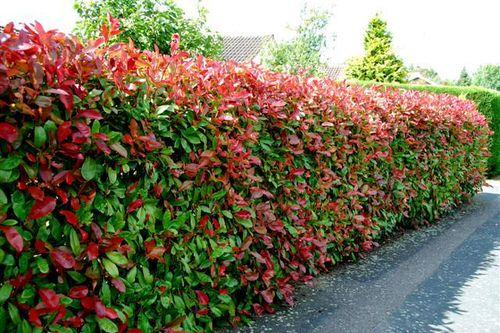
It is often difficult to decide which plant is the best fence line. Many people feel as though they want something that will be aesthetically pleasing, but also serve the purpose of providing the needed privacy.
One plant that works well in these types of situations is Photinia. Photinia trees provide excellent privacy due to their dense foliage and showy blooms, but also have vibrant color changes in the winter months. They grow quickly and can become an obstacle if not properly pruned. Pruning them periodically keeps them from becoming unruly.
One of the most beautiful features of this tree is its tendency to attract butterflies with its bright yellow flowers during the summer months. If you’re looking for a good fence-line plant with lots of color variation throughout the year, then Photinia should be at the top of your list!
3. Verbena Bonariensis
Talking of the other best plants for fence lines, Verbena Bonariensis is also one of the most popular choices for boundery. A perennial with purple and white variegated leaves, this plant can grow up to 3 feet tall and spread out to 2 feet wide.
There are many cultivars available that have green or cream leaves. Verbena is an excellent addition to any garden because it attracts hummingbirds and butterflies.
It also does well in clay soil which makes it an ideal choice for people with poor soil conditions.
The only downside is that you may need to trim the ends regularly if they begin to look straggly as they can become leggy over time.
Note: Verbena Bonariensis is short so it can only serve as a boundary and not a privacy fence.
4. Stipa Tenuissima
The other best plant for fence lines is Stipa Tenuissima. It’s drought tolerant and does well in the desert regions of California, Arizona, and New Mexico. It falls in the category of grass and not trees.
It thrives in coastal conditions as well, so it’s a good option if you live near the water and want to grow a beautiful hedge on your property line.
Stipa Tenuissima also attracts pollinators like bees and butterflies to your garden while providing an excellent source of food for local birds who can feed on its seeds year-round.
They’re usually planted along the garden boundary and are also great at controlling soil erosion.
5. Japanese Anemones

Japanese Anemones are one of the best plants for low fence lines. They look great in an informal garden setting and come in a variety of colors, including white, pink, purple, red, and yellow.
They will also thrive in any type of soil but do need well-drained soil to grow properly. Make sure you give them plenty of space to grow when planting them so they can form large clusters that can be seen from afar!
One of the best things about this plant is that it does not require much water or maintenance and it’s resistant to deer.
The downside is that their foliage can fade during periods of extreme heat (over 100 degrees Fahrenheit).
6. Libertia Chilensis
Another shrub type that can be used as a fence line is the Libertia Chilensis. It is a flowering plant with yellow flowers and purple leaves, which makes it an attractive addition to the landscaping of your property.
You can this plant in groups of three to five plants and have them follow the shape of your fence or property boundary to create some cohesion between the plants and your fencing.
7. Crimson Glory Vine
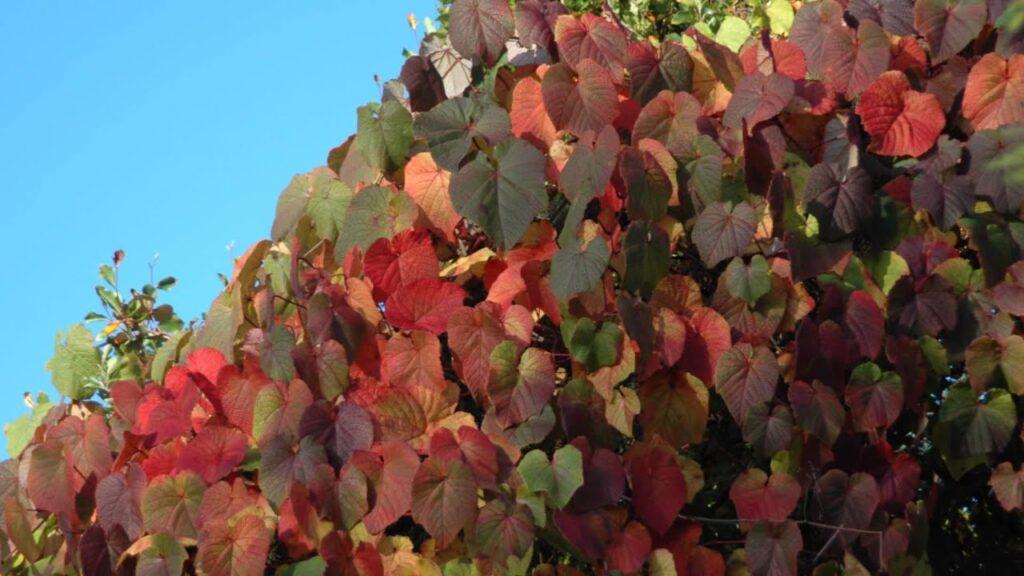
With leaves that look like the leaves of a grapevine, Crimson Glory Vine (Vitis Coignetiae) not only looks beautiful but also provides enough thickness for a line fence. It can grow up to 20 feet and is fast-growing so it will need frequent trimming.
Other benefits include deep red flowers in the summer and fall and deep green foliage year round. It grows well in most soils and thrives in full sun or partial shade. It’s hardy and can handle both dry spells as well as wet winters.
8. Roses
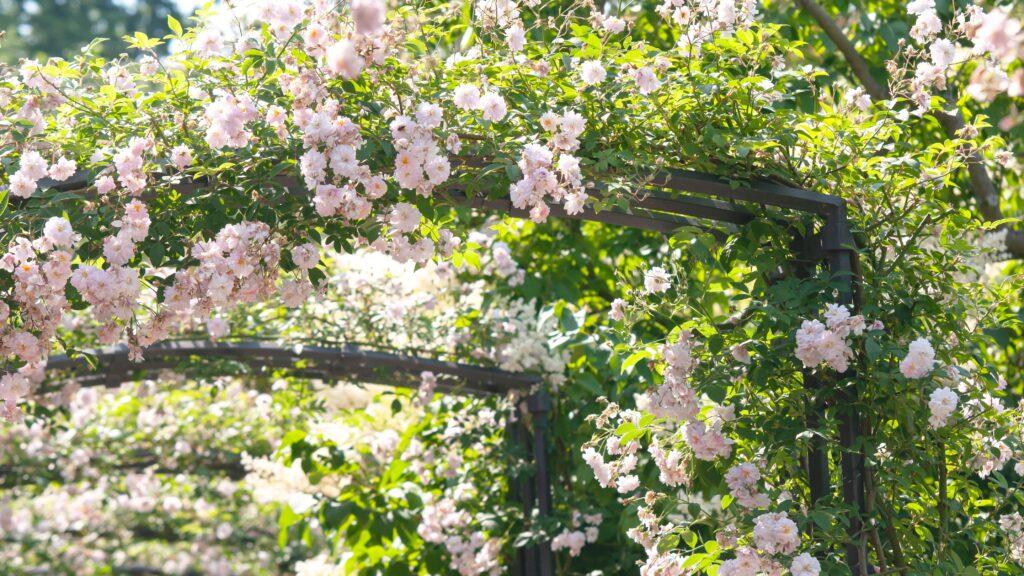
Some roses are one of the more popular plants used on fences because they are very fragrant and come in many colors including pink, white, yellow, peach, and many more colors.
They produce small clusters of five petals with an unusual yet pleasant fragrance that lasts even after they wither away.
They bloom between May to September depending on climate conditions which makes them perfect for adding color to your landscape during those months when other plants aren’t blooming as much or at all!
You can find roses in many colors and types. However, the roses that are mostly used for fences or on a fence are Ausmus, Lady Banks’ roses, and multiflora roses.
9. Jasmine

Common jasmine (Jasminum officinale) is an evergreen flowering vine that can climb as high as 20 feet. It is native to Asia and has naturalized in North America.
In some places, it has become invasive. Though it has fragrant flowers, the plant does not bloom until late summer or fall.
Its most notable features are its beautiful white flowers and the fact that it attracts pollinators like bees and butterflies.
A few cultivars include Japonica with white double blossoms, Alba with pure white blooms, Apple Blossom with yellow petals tinged with pink, and Peach Blossom with yellow petals tinged with apricot.
10. Coral Pea
Coral Pea can grow to heights of 6-10 feet and are drought tolerant. They grow as a vine and have showy flowers that produce pods that contain seeds.
The pods explode with seeds when they are ripe, releasing the seeds to create more plants. If left to their own devices, they will climb up trees or other vegetation and then just hang down.
There is no need to plant them in the ground or pot them up as they will just root wherever they find themselves dangling from.
They can also be propagated by breaking off branches and sticking them in moist soil or water for about two weeks. When roots form on the branch pieces, they should then be planted in moist soil or water.
11. Bougainvillea
The other best plant for fence lines is Bougainvillea. This is another popular plant you can use. It produces beautiful and vibrant flowers year-round.
The more sunlight it gets, the better it will do. It also can grow in clay soil, so don’t let that stop you from planting this one near your home.
One major downside to this plant is the deer love to eat it. If you have deer problems then steer clear of this one or at least get some netting over it as soon as possible.
12. Yew
The yew is one of the best plants to cover wire fences because it will grow quickly, stand up well to high winds, and form an impenetrable hedge. When pruning yews, the rule of thumb is to cut off any branches that are in shadow or that grow downward or away from the fence line.
Yews are resistant to deer and other browsers due to their dense foliage, though they can be damaged by an over-zealous or unprofessional pruner. Yews should be fertilized with an all-purpose feed twice a year in spring and fall as they need high levels of fertility while young but will develop deep root systems as they age.
13. Boxwood
Boxwood (Buxus sempervirens) is one of the best plants to cover wire fences because it is tolerant of shade and the salt that is used on many city streets. In addition, it grows fast and will not grow as tall as other evergreens.
It also provides a lot of nutrients in the form of nitrogen which will help keep your lawn looking healthy in between its trimming. This is good news as you can grow boxwood plants with other plants so that other plants benefit from them.
The only downside to this particular type of plant would be that boxwoods require regular pruning and can be fairly expensive to buy and maintain.
14. Crepe Myrtle
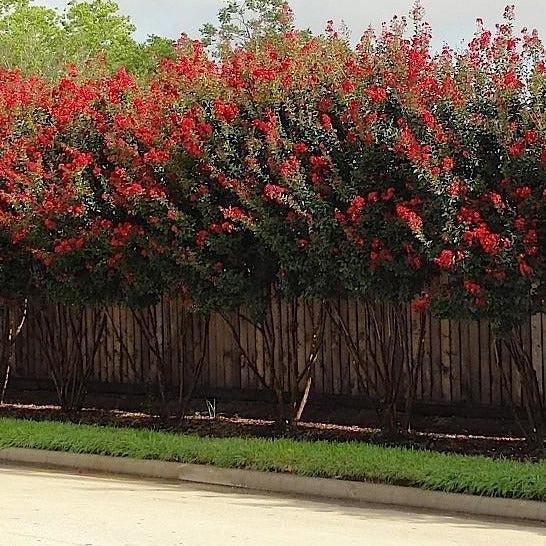
The Crepe Myrtle is the other best plant to cover up wire fences. It is also resistant to insect infestation and powdery mildew, making it the perfect low-maintenance landscape choice. And with a 6-8 foot tree life expectancy, they can provide privacy while looking beautiful too!
As with any trees, pruning should be done in late winter or early spring. Lightly prune to keep branches open and allow light penetration, removing broken or dead branches as necessary.
During this time, you also need to fertilize with an organic fertilizer such as compost around the drip line of the tree. When planting your crepe myrtle you want about 10 feet on either side of the fence for good coverage, so make sure you have enough room when selecting your location!
15. Arborvitae shrub

The other plant that is mostly used for fences is the Arborvitae. People prefer this shrub because of its ability to grow high and thick which gives most people privacy.
The Plant grows between 12 to 24 inches per year. It does not produce more stressed-out branches as such they don’t need hard pruning. Plus, the arborvitae shrubs don’t grow fast when they have been pruned hard.
However, this does not mean you should not prune the Arborvitae shrub. You just need to trim them gently to give them the look you want.
16. Privet shrub
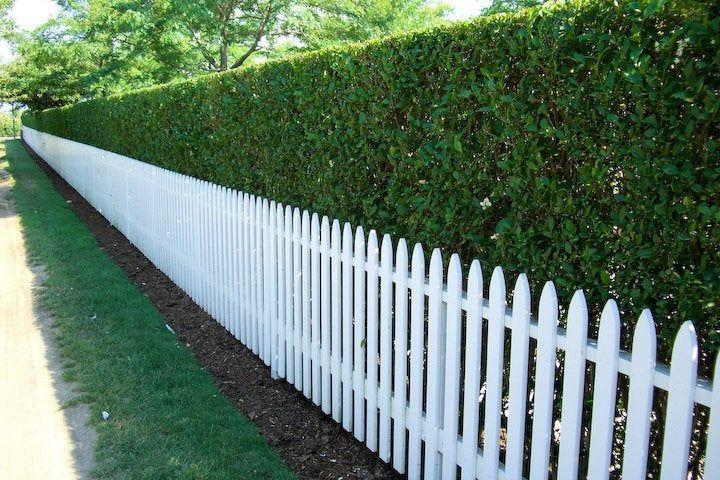
The privet plant is an evergreen shrub that is usually grown as a hedge or a fence line. It’s one of the best plants for a fence line. It grows between one and two feet per year when it’s receiving enough water.
The downside of the privet shrub is that its leaves and berries are poisonous to animals and people.
FAQs About the Best Plants for Fence Lines
I’ve decided to include this section to help you decide on the best plant for a fence line.
What is the Plant to Grow along a Fence?
The 7 best plants to grow along a fence are (1) white dogwood, (2) common garden sage, (3) hellebore, (4) winterberry, (5) lamb’s ear, (6) purple coneflower, and Siberian iris.
With their stunning flowers and attractive foliage, these perennials will give your property an added layer of privacy. Plus, you’ll have some great low-maintenance shrubs to add as border plants in front of other sections of your fence!
What are the Fastest Growing Climbing Plants?
The fastest-growing climbing plant is the English Ivy. It can grow up to 1 inch per day, but it has been known to grow up to 3 inches per day in optimal conditions. In contrast, the slowest growing climbing plants are strawberry and blueberry bushes.
What is the Fastest Way to Cover a Fence?
There are some ways to cover a fence -especially a wire fence. But the fast track to cover a fence is with plants! The top three plants that cover a fence fast are the Osmanthus, Cherokee Rose, and Jasmine. These types of plants not only cover a fence quickly but also provide an attractive and fragrant backdrop. Some other great choices include Crepe Myrtle, Rosemary, Hibiscus, Gardenia, and Hydrangea. You can also try planting thick hedges like boxwood or hemlock if you want to create an instant privacy screen for your property line (and if you have room).
What is the best plant to cover a wire fence?
The English Ivy plant is one of the best plants to cover a wire fence because it has green leaves that grow quickly. It is also good at providing shade from the sun.
Another good plant to use is the Eastern Redbud tree because it has pink flowers and purple or red berries. If you have trees on your property, then try planting some hawthorn bushes or spicebush to provide coverage.
There are many different options when it comes to planting along your fence line, so choose the one that best suits your needs!
Whether you’re just researching or you’re looking for a plant to use as a fence line, this post provides you with all the information you need. Either way, I wish you the best of luck.



